Background .:. Top
Auditoriums are designed to project sound in the most efficient way possible. On its own, sound in an open space would travel outwards and disperse in as many directions as possible. With this in mind, auditoriums have many special features that help direct the sound. “The most widely used passive acoustical treatment for an auditorium stage is an acoustical shell” (Sound and Video Contractor). There are many types of shells, including some which are permanent fixtures. Another common fixture is panels called clouds. Clouds, according to Sound and Video Contractor, “help improve sound projection to the audience”. The materials used are also important in how the space carries sound. For example, certain thicknesses of fiberglass absorb lower frequencies, and drapes often absorb higher frequencies. Another issue affecting sound quality is the positioning of the walls and ceiling. “Untreated parallel wall surfaces can cause undesirable flutter echoes and standing waves, in which certain frequencies become overemphasized” (Sound and Video Contractor).
Statement of the Problem .:. Top
The purpose of this investigation is to evaluate the Tualatin High School Auditorium and determine whether there is even distribution of sound. We will be looking for “dead spots”, or really “live spots”, and creating a “map”, per se, of the auditorium. Sound intensity will be measured in decibels, and a “dead spot” is where the intensity drops off considerably. A “live spot” on the other hand, is a location where the intensity heard is true to the intensity produced.
Review of Literature .:. Top
Part of the Norsonic website explains the difference between sound power and sound pressure. “If you put a noise source in a room, it will emit a certain sound power which in turn will put up a certain sound pressure. The sound pressure level will depend on such things as the amount of reflections of sound from the wall, the amount of sound being transmitted into adjacent rooms (and this not returning) etc.” (Norsonic 2004). It also explains that “we hear sound pressure, rather than sound power” and that although “the decibel is defined in the power domain ... through mathematics we can also use if for sound pressure levels” (Norsonic 2004).
An online physics tutorial (Henderson, 1996) was originally used for Glenbrook South High School of Glenview, Illinois, and explained intensity and the decibel scale. Intensity is defined as energy/time/area, or power/area. This is typically expressed in Watts/meters2. It also explains the inverse square relationship, which basically says that the intensity varies inversely with the square of the distance from the source. This is because sound waves are distributed in circular (2 dimensions) or spherical (3 dimension) patterns, causing the same amount of “stuff” to be spread out over a greater area, causing the intensity to lessen. This tutorial was also quick to point out that loudness and intensity are not the same because intensity can be measured and loudness is subjective according to different individuals. However, it did say that more intense sounds will be generally perceived as louder.
Sound travels in waves, specifically longitudinal waves. These waves carry energy through them. When discussing sound, two of the main variables are loudness and pitch. We will be dealing with loudness. “Loudness is related to the energy in the sound wave” (Giancoli, 1998). Loudness in turn is related to intensity, which is a measurable quantity. “Intensity is defined as the energy transported by a wave per unit time across unit area and is proportional to the square of the wave amplitude” (Giancoli, 1998). This can also be stated that intensity is power divided by area, and intensity is given by the formula:
I = P/4Πr²
Another useful formula is as follows:
I²/I² = r1²/r2²
Sound intensity is measured in bels, named after Alexander Graham Bell, the inventor of the telephone. The more commonly used measure is the decibel, because bels are often too large. The intensity level in decibels can be found by
10 log (I/I0)
where I is the intensity and I0 is the “threshold of hearing” or 1.0*10^-12 W/m2.
According to another source, “a measure of good acoustics is demonstrated in the ability to enhance the sound quality in the environment where people come to listen… The primary goal is to enhance the reflected sound” (Spence 2004). This lists 5 steps that can be taken to ensure good quality sound. “The sound should be loud enough everywhere; the sound should be adequately distributed around the room; there should [be] enough clarity; the room should be free of echoes; and the room should be free of extra noise” (Spence 2004).
The Georgia State Physics webpage says that “desirable acoustic
properties of the auditorium can be contributed to its architecture” (Nave
2003). It also adds that “even
dispersion is usually achieved by avoiding any focusing surfaces and avoiding
large flat areas which reflect sound into the listening area.
Sometimes it is desirable to add some anti-focusing surfaces” (Nave
2003).
Hypothesis .:. Top
We believe that as we measure the sound intensity, it will lessen as we travel farther from the sound source. Sound intensity will be measured in decibels, and a “dead spot” is where the intensity drops off considerably. A “live spot” on the other hand, is a location where the intensity heard is true to the intensity produced. Therefore, we believe the best location will be in the area directly in front of the stage because the sound will travel directly to that location and will not have time to disperse unevenly. We also believe that the auditorium will have a fairly even distribution of sound because of added materials like clouds.
Method .:. Top
We placed one speaker on the edge of the stage in the center of the stage, with all of the sound equipment behind and to the right of the speaker. The speaker faces straight ahead. We produced a pure tone using the test tone that was a part of the sound system. Next we used a decibel meter to measure the volume directly in front of the speaker, and proceeded to measure the volume at any other location in the auditorium by placing a textbook on the seat and then the decibel meter on the book to minimize any effect holding the decibel meter might have on the reading. The following diagram shows the set up and the seats where we initially measured the volume as if you were seeing the auditorium from a bird’s eye view. We set up our experiment this way so we could look for patterns in how the sound changes as it moves through the different areas of the auditorium.
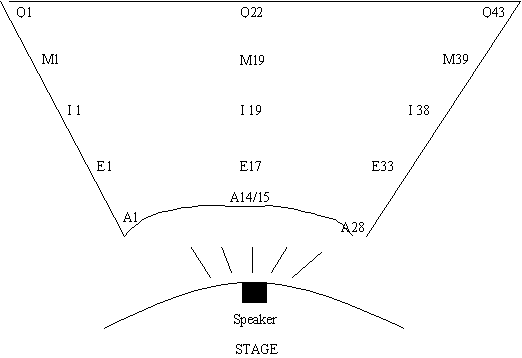
Results .:. Top
The following is the data we collected during our second trial.
“Audience Right” means the seats are on the right side of the
auditorium from the audience’s point of view.
“Audience Left” means the seats on the left side of the auditorium
from the same perspective.
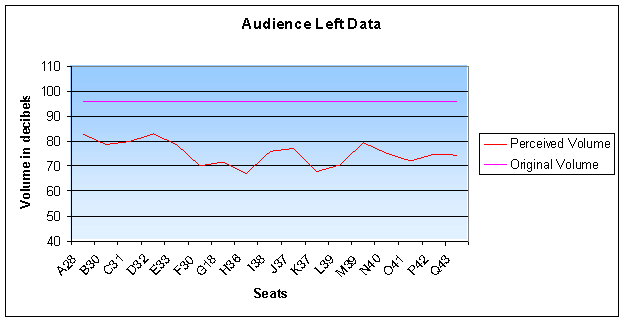
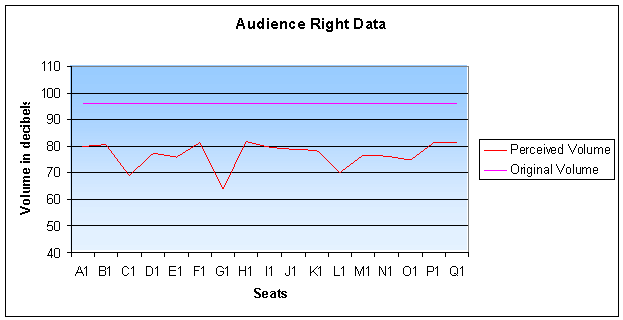
|
Seat
(Audience Right) |
Percent
Sound Retained |
|
Seat
(Audience Left) |
Percent
Sound Retained |
|
A1 |
83.33% |
|
A28 |
86.35% |
|
B1 |
84.06% |
|
B30 |
81.98% |
|
C1 |
71.77% |
|
C31 |
83.33% |
|
D1 |
80.73% |
|
D32 |
86.46% |
|
E1 |
79.06% |
|
E33 |
82.08% |
|
F1 |
84.58% |
|
F30 |
72.92% |
|
G1 |
66.67% |
|
G18 |
74.79% |
|
H1 |
85.10% |
|
H36 |
69.79% |
|
I1 |
82.81% |
|
I38 |
79.27% |
|
J1 |
82.08% |
|
J37 |
80.21% |
|
K1 |
81.77% |
|
K37 |
70.63% |
|
L1 |
72.92% |
|
L39 |
73.65% |
|
M1 |
79.79% |
|
M39 |
82.81% |
|
N1 |
79.38% |
|
N40 |
78.33% |
|
O1 |
78.02% |
|
O41 |
75.00% |
|
P1 |
84.58% |
|
P42 |
78.13% |
|
Q1 |
84.90% |
|
Q43 |
77.60% |
In looking at the uncertainty of our experiment, there are a lot of factors that could contribute. The decibel meter was difficult to read because it rarely settled on one number for any longer than a fraction of a second, and there was a possibility that humans being near it could affect the reading. In our first trial, we turned the sound off in-between readings, so the volume was probably not constant throughout the first trial (we corrected this problem for the second trial). Our data could also be affected by the fact that we tested one pitch, a relatively high one, and sound could have been absorbed by certain materials in the auditorium that react to different pitches. If this is true, the spots that absorbed the sound might have reacted differently with a different pitch. So our data can really only be considered accurate for the pitch we used.
As far as structural characteristics that could affect the results, even on the edge of the stage it is possible to lose some sound to the huge space above the stage. Also, during our second trial the pit cover was up, whereas in the first trial it was not.
Discussion .:. Top
Our first hypothesis states that we believe the sound intensity will lessen as we move farther away from the sound source with the decibel meter. Our initial test proved this hypothesis to be true, showing right away even in the first row of seats that the volume drops off quite a bit from the original volume. The volume continued to drop as we moved away from speaker. However, after the initial drop, it only drops a total of 15.4 decibels throughout the rest of the auditorium, which indicates that the auditorium is doing a fairly good job of combating this sound loss.
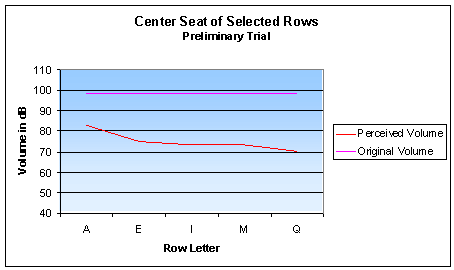
Our second hypothesis is that we believe the best location for hearing a sound most true to the original will be directly in front of the stage because sound will travel directly to that location. This hypothesis also proved to be true, because while the auditorium is built to keep the sound from dropping off too quickly, the sound still does drop off. Our data shows that in the preliminary trial the sound in the center of the first row was 84% of the original sound. The audience’s left and right sides retained 72.5% and 71%, respectively. In our secondary trial the audience’s left and right sides retained 86.4% and 83.3%, also respectively.
However, there are six other locations where the retention is 84% or greater that are not in the immediate front of the auditorium. Our third hypothesis addresses this issue, stating that we believe the auditorium has a fairly even distribution of sound due to the addition of reflective materials like clouds. The auditorium has three large clouds (light blue in diagram) hanging, one on the edge of the stage and two in the audience. It also has a number of reflectors (light purple in diagram) on the side walls of the auditorium. The floor also slopes upward as you move towards the back of the audience. We believe these are all factors in even distribution of sound.
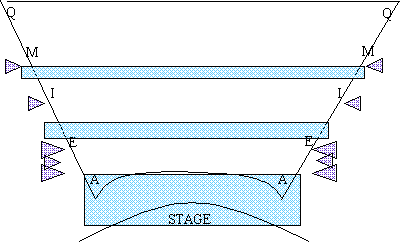
We believe that these reflectors and clouds added to the percent of sound retained in those five spots. Seat B1 is the first location where the percentage remains fairly even with the front row of seats. The percentage retained is 84.06% and we believe this is because the main cloud extends out over the seats a little and there is a reflector centered at row B. The second spot is in seat D32. This seat is affected by the first three triangle reflectors on the audience’s left. We believe that the sound reflected off of the triangle shapes and added sound to that location that wouldn’t have been heard without the reflectors. The retention percentage was 86.46%. The third location is seat F1. The cloud centered above rows E and F is key in this spot, bringing the percent retained up from 79.06% in seat E1 to 84.58% in seat F1.The third high percent of retention, 85.1%, is in seat H1. There is a small reflector centered at row H and we believe that reflector brings up the percentage. The fifth and sixth locations were in seats P1 and Q1, respectively. While there are no clouds or reflectors in this area, the auditorium slopes up the farther back in the audience you go. We believe that because rows P and Q are in the very rear of the auditorium and therefore the most elevated, the sound reaches those rows slightly more directly, resulting in the higher percentages of retention.
Another
interesting variable to look at is the frequency of the pitch used to test the
sound retention. We used a
relatively high pitch, and would like to see what would happen if a lower
pitch was used instead. Freiheit, Ron.
(2004). “Sound
and Video Contractor: Tailored for Sound” .
An interesting article of effective rehearsal and performance spaces
that helped us understand what goes into making an effective auditorium. Giancoli, Douglas C.
(1998) Physics: Principles with Applications.
Prentice Hall. New Jersey.
This section of our physics text helped us better understand sound intensity. Henderson, Tom. (1996). “Intensity
and the Decibel Scale”.
This added to our understanding of
intensity and the inverse square relationship it has with space. Nave, C.R.
(2003). “Architecture
for Acoustics”.
This website explains the desirable
properties of an acoustic space. Norsonic (2004). “Introducing
the Decibel”.
This page better explains sound power,
sound pressure, and decibels. Spence, Lewis L.
(2004). “Discovering
the Mathematics of Sound”.
This is yet another source describing
ideal acoustics.
We would like to thank Mr. Murray for his help with this research
project. He was always available
for consultation, and offered us the use of his decibel meter, which we
gratefully accepted. We would
also like to thank Mr. Clark for letting us use the auditorium.
He was very gracious when we presented our request to use the
auditorium for our research experiment. Senior
Tim McNaught also played a large role in our project; he offered his expertise
with sound systems and his time to help us conduct our experiment.
We would like to thank you each for your contribution to this project
and, we believe, its success. 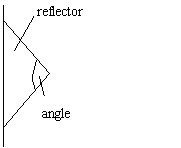 Because
our data supports the hypothesis that reflectors and clouds affect the percent
of sound retention, it would be interesting to experiment with the angles
formed by the reflectors. Perhaps
by decreasing the angle, the reflectors will “catch” the sound more
directly and reflect more strongly on the seats closest to them.
On the other hand, decreasing the
angle could result in just sending the sound back towards the place from which
it originated.
Because
our data supports the hypothesis that reflectors and clouds affect the percent
of sound retention, it would be interesting to experiment with the angles
formed by the reflectors. Perhaps
by decreasing the angle, the reflectors will “catch” the sound more
directly and reflect more strongly on the seats closest to them.
On the other hand, decreasing the
angle could result in just sending the sound back towards the place from which
it originated.
Bibliography and Related Web Sites .:. Top
Acknowledgements .:. Top